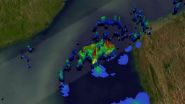(Press-News.org) New research suggests that drugs commonly used to prevent organ rejection after transplantation may also be helpful for combating HIV. The findings, which are published in the American Journal of Transplantation, suggest a new strategy in the fight against HIV and AIDS.
Despite the effectiveness of antiviral therapies at suppressing HIV, the virus still persists indefinitely at low levels in infected patients who are diligent about taking their medications. "Current therapies fail to cure the disease as they do not attack those viruses that remain hidden within the immune system," said Steven Deeks, MD, of the University of California, San Francisco. Researchers suspect that inflammation in the body in response to HIV infection may create an environment that supports this viral persistence.
Dr. Deeks and his colleagues wondered whether immunosuppressant therapy could reduce such inflammation and therefore help defeat HIV. To investigate, the team looked at how HIV infection is affected by immunosuppressants that are commonly taken by kidney transplant recipients to reduce their risk of rejection. The analysis included 91 recipients who were followed for a median of 3.2 years post-transplant.
When the investigators analyzed blood samples from the study participants, they found that HIV remained well-controlled following transplantation and long-term exposure to immunosuppressive drugs. Importantly, they also discovered that patients who took a particular immunosuppressant called sirolimus as part of their treatment regimen had fewer cells in their blood that were infected with HIV over time. The findings suggest that immune-modifying drugs such as sirolimus may affect the level of HIV persistence. "Based on the observations in this study, the NIH is now sponsoring a targeted study to see if sirolimus might indeed contribute to a cure of HIV infection," said Dr. Deeks.
Dr. Deeks, who is an HIV researcher and clinician, noted that the work was done in collaboration with UCSF transplant surgeons led by Peter Stock, MD, PhD, and study coordinator Rodney Rogers. "Our study highlights the potential synergies that can occur when two very different disciplines merge their talents and resources," said Dr. Deeks. "We feel that the transplant community has much to teach the HIV community about the potential role of strong immune-suppressing drugs in curing HIV disease."
The results come only several months after the federal government passed legislation—called the HIV Organ Transplant Equity (HOPE) Act—to end the federal ban on the transplantation of HIV-positive organs to patients with HIV.
INFORMATION:
Transplant drugs may help wipe out persistent HIV infections
2014-04-03
ELSE PRESS RELEASES FROM THIS DATE:
Stroke risk higher after shingles, but antiviral drugs may provide protection
2014-04-03
[EMBARGOED UNTIL THURSDAY, APRIL 3] Patients' risk of stroke significantly increased following the first signs of shingles, but antiviral drugs appeared to offer some protection, according to a new study in Clinical Infectious Diseases, now available online. People with shingles, an often painful skin rash caused by the same virus that causes chickenpox, had a higher stroke risk in the first 6 months after shingles symptoms appeared; this risk was particularly increased in patients with a rash near their eyes, the study found.
Shingles, or herpes zoster, is a significant ...
A brain region for resisting alcohol's allure
2014-04-03
As recovering spring breakers are regretting binge drinking escapades, it may be hard for them to appreciate that there is a positive side to the nausea, sleepiness, and stumbling. University of Utah neuroscientists report that when a region of the brain called the lateral habenula is chronically inactivated in rats, they repeatedly drink to excess and are less able to learn from the experience. The study, published online in PLOS ONE on April 2, has implications for understanding behaviors that drive alcohol addiction.
While complex societal pressures contribute to alcoholism, ...
Magnetic anomaly deep within Earth's crust reveals Africa in North America
2014-04-02
Boulder, Colo., USA – The repeated cycles of plate tectonics that have led to collision and assembly of large supercontinents and their breakup and formation of new ocean basins have produced continents that are collages of bits and pieces of other continents. Figuring out the origin and make-up of continental crust formed and modified by these tectonic events is a vital to understanding Earth's geology and is important for many applied fields, such as oil, gas, and gold exploration.
In many cases, the rocks involved in these collision and pull-apart episodes are still ...
NASA releases images of M-class solar flare
2014-04-02
On April 2, 2014, the sun emitted a mid-level solar flare, peaking at 10:05 a.m. EDT, and NASA's Solar Dynamics Observatory captured imagery of the event. Solar flares are powerful bursts of radiation. Harmful radiation from a flare cannot pass through Earth's atmosphere to physically affect humans on the ground, however -- when intense enough -- they can disturb the atmosphere in the layer where GPS and communications signals travel.
To see how this event may impact Earth, please visit NOAA's Space Weather Prediction Center at http://spaceweather.gov, the U.S. government's ...
NASA sees Tropical Cyclone's Hellen's lively remnants
2014-04-02
Powerful Tropical Cyclone Hellen rapidly weakened after hitting northwestern Madagascar but Hellen's remnants have recently started to show signs of life. The TRMM satellite flew over these remnants in the Mozambique Channel on April 2, 2014 at 0143 UTC.
A rainfall analysis using the Tropical Rainfall Measuring Mission's (TRMM) Microwave Imager (TMI) and Precipitation Radar (PR) instruments found that some strong convective thunderstorms had developed in the area. It was revealed by TRMM PR data that rain was falling at a rate of over 75 mm/~ 3 inches in a few locations.
TRMM's ...
River ice reveals new twist on Arctic melt
2014-04-02
A new study led by Lance Lesack, a Simon Fraser University geographer and Faculty of Environment professor, has discovered unexpected climate-driven changes in the mighty Mackenzie River's ice breakup. This discovery may help resolve the complex puzzle underlying why Arctic ice is disappearing more rapidly than expected.
Lesack is the lead author on Local spring warming drives earlier river-ice breakup in a large Arctic delta. Published recently in Geophysical Research Letters, the study has co-authors at Wilfrid Laurier University, the University of Alberta and Memorial ...
Body odor changes following vaccination
2014-04-02
PHILADELPHIA (April 2, 2014) – Our understanding of the role of body odor in conveying personal information continues to grow. New research from the Monell Chemical Senses Center and the U.S. Department of Agriculture (USDA) reveals that immunization can trigger a distinct change in body odor. This is the first demonstration of a bodily odor change due to immune activation.
The findings will appear in the April 10 issue of Physiology and Behavior. In addition, portions of the work will be presented on April 10 at the 36th Annual Meeting of the Association for Chemoreception ...
Science-themed music videos boost scientific literacy, study shows
2014-04-02
As the United States puts ever-greater emphasis on science, technology, engineering and mathematics education to keep competitive in the global economy, schools are trying to figure out how to improve student learning in science.
University of Washington researchers Katie Davis and Greg Crowther think music may be the answer for some kids. They studied the ability of music videos to enhance students' understanding of scientific concepts.
Davis will present "Sing about Science: Leveraging the Power of Music to Improve Science Education" on Friday (April 4) at the American ...
Gauging the impact of tropical forest logging: Winrock develops new method for quantifying carbon emissions
2014-04-02
ARLINGTON, Va. (April 2, 2014) — Researchers at Winrock International have developed a first-of-its-kind method for estimating carbon emissions from forest degradation caused by selective logging in tropical regions. Refined over a period of 15 years and tested in six countries, the approach is highlighted in an article authored by Winrock's Ecosystems Services experts, Timothy Pearson, Sandra Brown and Felipe Casarim — published April 1 in Environmental Research Letters.
Until now, efforts for reducing emissions from deforestation and forest degradation (REDD+) in developing ...
NIST's simple microfluidic devices now have valves
2014-04-02
Researchers at the National Institute of Standards and Technology (NIST) have added yet another innovation—miniature valves—to their ever-growing collection of inexpensive, easy-to-manufacture and highly efficient microfluidic devices made from plastic films and double-sided tape.
Traditionally, microfluidic devices—tiny gadgets with fluid-carrying channels used in medical diagnostics, DNA forensics and "lab-on-a-chip" chemical analyzers—have been fabricated like microchips using photolithography. A desired pattern of micrometer-sized channels and ports is created on ...




